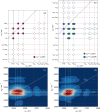Two-Dimensional Electronic Spectroscopy of Rhodamine 700 Using an 8 fs Ultrabroadband Laser Source and Full-Wavelength Reference Detection
- PMID: 40043307
- PMCID: PMC12010339
- DOI: 10.1021/acs.jpca.4c08494
Two-Dimensional Electronic Spectroscopy of Rhodamine 700 Using an 8 fs Ultrabroadband Laser Source and Full-Wavelength Reference Detection
Abstract
Two-dimensional electronic spectroscopy (2DES) is one of the premier tools for investigating photoinduced condensed phase dynamics, combining high temporal and spectral resolution to probe ultrafast phenomena. We have coupled an ultrabroadband laser source generated with a hollow-core fiber, compressing pulses to have a pulse duration of 8 fs, with a boxcars 2DES interferometer constructed from only conventional optics. The resulting ultrabroad bandwidth and high temporal resolution allow for superior spectral coverage of the typically broad molecular line shapes in the near-IR/visible region in room temperature solutions, and the exploration of the excited state dynamics at the earliest time epoch in complex systems. The new spectrometer is characterized by examining the dynamics of the dye molecule Rhodamine 700 in methanol solution. These data exhibit rich vibrational wavepacket dynamics, with 2DES data unraveling key molecular vibronic couplings between multiple vibrational modes. For the first time in a degenerate broadband 2DES experiment, we demonstrate the implementation of full-wavelength reference detection to correct wavelength-dependent laser intensity fluctuations. The net result is a 4-5× increased signal-to-noise (S/N) ratio compared to data acquired without reference detection, yielding a typical S/N ratio = 28. The increased S/N ratio facilitates more rapid data acquisition and examination of samples at lower optical densities, and thus concentrations, than typically used in 2DES experiments. These advances will help to alleviate the typical high demands on precious samples in 2DES measurements.
Conflict of interest statement
The authors declare no competing financial interest.
Figures









References
-
- Lee Y.; Das S.; Malamakal R. M.; Meloni S.; Chenoweth D. M.; Anna J. M. Ultrafast Solvation Dynamics and Vibrational Coherences of Halogenated Boron-Dipyrromethene Derivatives Revealed through Two-Dimensional Electronic Spectroscopy. J. Am. Chem. Soc. 2017, 139 (41), 14733–14742. 10.1021/jacs.7b08558. - DOI - PMC - PubMed
LinkOut - more resources
Full Text Sources

